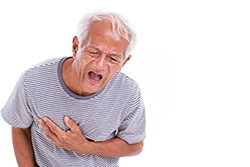A new breathing monitor signals the coming generation of pervasive healthcare
Researchers recently announced the development of technology which can monitor breathing rates using mobile phones. The team, publishing their results in the journal ‘Biomedical Optics Express’, report how they created new software to be used in conjunction with an inexpensive thermal camera. Breathing rates were tested in simulated real-world situations involving a variety of movements and temperature changes, with the device performing well. Low-cost thermal cameras and a game-changing algorithm Enabling the new device to be mobile phone compatible increases its pervasive potential, as well as the likelihood of user adoption. As leader of the research team Professor Nadia Bianchi-Berthouze from University College London explains, ‘By using low-cost thermal cameras, our work is a first step toward bringing thermal imaging into people's everyday lives. This approach can be used in places other sensors might not work or would cause concern.’ For example, the researchers point out that thermal cameras can detect breathing both during night and day, without the need for special sensors. Additionally, thermal imaging largely protects an individual’s identity, unlike conventional cameras. Professor Bianchi-Berthouze’s approach of investigating the body’s posture/movement as a means to recognise, modulate and measure human affective states, was also developed under the EU-funded UBIHEALTH project. UBIHEALTH brought together researchers from Europe and beyond, to stimulate collaborative and novel solutions for healthcare challenges which are increasing straining healthcare systems. This pervasive healthcare approach marks a shift from treatment towards prevention, which requires less resources and is especially applicable to both the needs of an ageing population and the increase of lifestyle-related diseases, such as cardio-vascular problems. Surmounting challenges Infrared wavelengths allow thermal cameras to detect temperature, and have long been used in monitoring devices. More recently, their size and cost have substantially reduced making them available for more mobile personal use. ‘However, we found that in real-world situations this type of mobile thermal imaging was affected by changes in air temperature and body movement,’ reflects project researcher and lead author Youngjun Cho. To get around this challenge the team developed algorithms that both accurately track nostrils during movement and can compensate for temperature changes. The researchers also increased the accuracy of temperature readings by using 3D, rather than 2D, approaches. They found that across both laboratory-based tests and indoor/outdoor walking exercises, the device outperformed comparable alternatives and are now working to adapt the software to monitor breathing rates in real time. Prevention better than cure There is currently a range of likely health scenarios where the device could be deployed. For instance, it could monitor breathing problems amongst the elderly population, especially those living alone, or of babies at risk of sudden infant death syndrome (SIDS). Beyond these applications, the camera could also be integrated into computers to detect breathing irregularities associated with stress and then respond with relaxation prompts. Looking to the future Professor Bianchi-Berthouze says, ‘As thermal cameras continue to get smaller and less expensive, we expect that phones, computers and augmented reality devices will one day incorporate thermal cameras that can be used for various applications.’ When combined with complementary monitoring devices such as for heart-rate, the range of possible applications could truly herald the age of what has been called ‘pervasive healthcare’. For more information, please see: CORDIS project webpage
Countries
Italy



